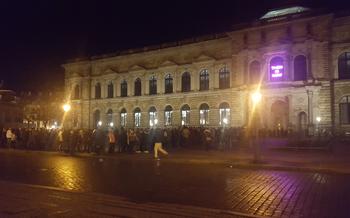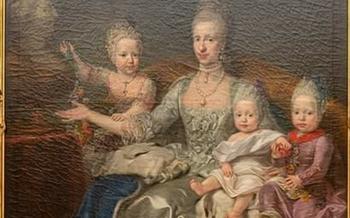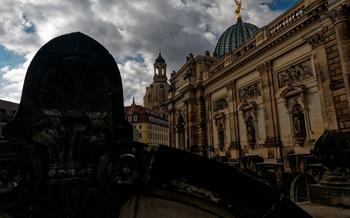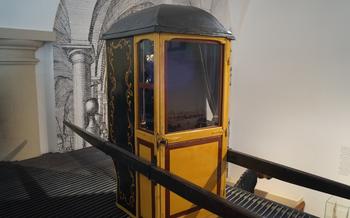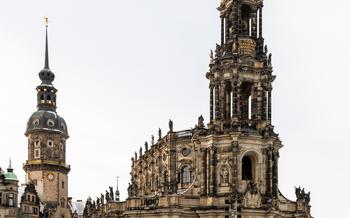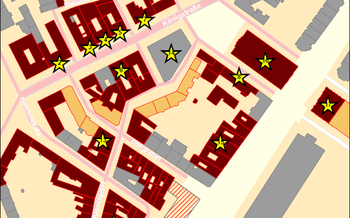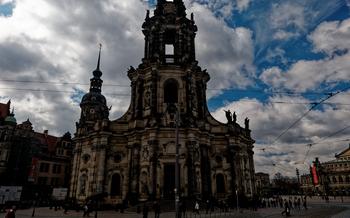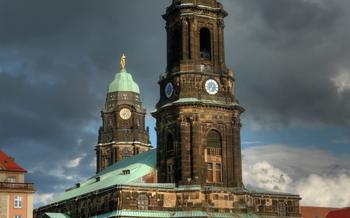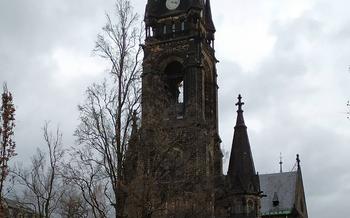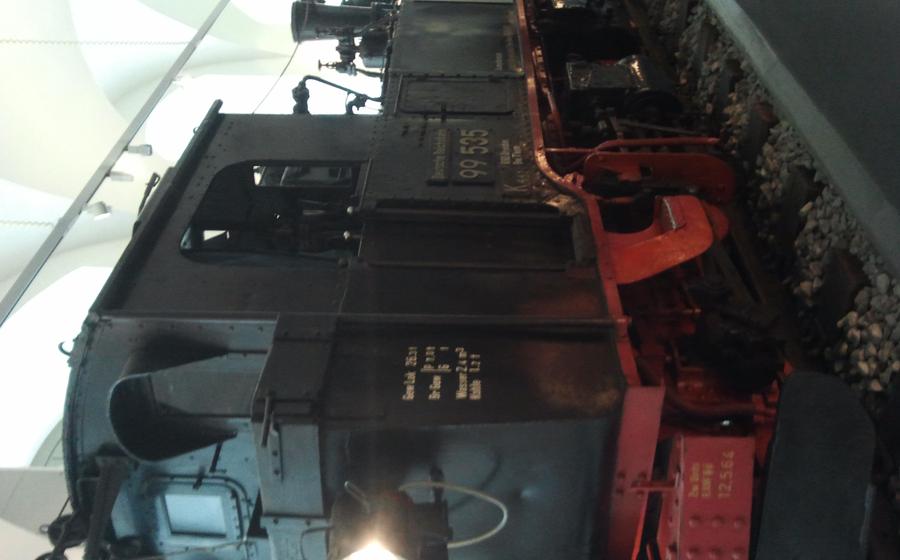
Verkehrsmuseum Dresden
- A City of History and Culture
- The Verkehrsmuseum Dresden
- Transportation History on Display
- Railroading in Germany
- Aviation and Space Exploration
- Maritime History
- Automotive and Motorcycle Exhibits
- Special Exhibitions
- Guided Tours and Workshops
- Museum Shop and Café
- Planning Your Visit
- Getting to the Museum
- Nearby Attractions
- Accommodations and Dining
- Insider Tip
A City of History and Culture
Dresden, the capital of Saxony, is a vibrant city with a rich history and cultural heritage. Located on the banks of the Elbe River, Dresden is known for its stunning architecture, world-class museums, and vibrant arts scene. The city's history dates back to the 13th century, and it has played a significant role in German history, serving as the residence of the Saxon kings and electors. Dresden is also renowned for its architectural landmarks, including the Frauenkirche, a magnificent Baroque church that was rebuilt after being destroyed during World War II, and the Zwinger Palace, a former hunting lodge that now houses several museums. The city's cultural heritage is reflected in its many museums, theaters, and concert halls, as well as its traditional festivals and events. Whether you're interested in history, architecture, art, or music, Dresden has something to offer every visitor.
The Verkehrsmuseum Dresden
The Verkehrsmuseum Dresden, also known as the Dresden Transport Museum, is a comprehensive museum dedicated to the history and evolution of transportation in Germany. Situated in the vibrant city of Dresden, this renowned institution offers a captivating journey through the world of mobility, showcasing an impressive array of exhibits that span various modes of transport, from ancient carriages to cutting-edge aircraft and space technology.
The museum's vast collection encompasses a diverse range of artifacts, including meticulously restored locomotives, vintage automobiles, historic ships, and an awe-inspiring array of aircraft. Interactive displays, hands-on exhibits, and informative panels provide visitors with an immersive and educational experience, allowing them to delve into the intricacies of transportation engineering, explore the impact of mobility on society, and appreciate the artistic and cultural significance of vehicles through the ages.
Transportation History on Display
The Verkehrsmuseum Dresden offers a captivating journey through the evolution of transportation technology, showcasing a diverse collection of exhibits and displays that bring the history of transportation to life. Visitors can explore the remarkable achievements and innovations that have shaped the way we travel and move goods across land, sea, and air.
Interactive Exhibits
The museum features a range of interactive exhibits that invite visitors to engage with the history and science of transportation. Visitors can navigate virtual ship bridges, test their driving skills in racing simulators, and explore the inner workings of engines through interactive displays. These interactive experiences provide an entertaining and educational way to learn about the challenges and breakthroughs in transportation technology.
Historical Artifacts
The museum houses an impressive collection of historical artifacts that tell the story of transportation's development. Visitors can marvel at vintage locomotives, classic cars, and antique aircraft, each with its own unique tale to tell. The museum's collection also includes a variety of rare and one-of-a-kind artifacts, such as the world's first steam-powered locomotive, the "Rocket," and the original plans for the first Zeppelin airship.
Railroading in Germany
Germany has a long and storied history of railroading, with some of the earliest locomotives and steam engines developed and produced in the country. The Verkehrsmuseum Dresden showcases this rich heritage with a vast collection of locomotives, rolling stock, and interactive model railroad layouts.
Visitors can marvel at the evolution of railroad technology, from the early steam-powered locomotives to the sleek and modern high-speed trains of today. The museum's collection includes both German-made locomotives, such as the iconic DR Class 1201 steam locomotive, as well as locomotives from other countries, demonstrating the global impact of German engineering.
One of the highlights of the museum's railroad exhibits is the interactive model railroad layouts. These miniature railroads, complete with detailed landscapes, moving trains, and sound effects, bring the history of railroading to life. Visitors can control the trains themselves, creating their own railroad adventures and learning about the challenges and complexities of railroad operations.
The museum also hosts special events and exhibitions related to railroading throughout the year. These events often feature guest speakers, historical reenactments, and hands-on activities, providing visitors with a deeper understanding of the role that railroads have played in German history and culture.
Aviation and Space Exploration
The Verkehrsmuseum Dresden also houses an impressive collection of aircraft and spacecraft exhibits, taking visitors on a journey through the history of aviation and space exploration. Model rockets and space exploration artifacts, these exhibits offer an immersive experience that showcases the pioneering spirit and technological advancements that have shaped these fields.
Interactive flight simulators provide a thrilling opportunity for visitors to experience the sensation of flight and learn about the principles of aerodynamics. Budding astronauts can explore a replica of the International Space Station, while aviation enthusiasts can marvel at the evolution of aircraft design and engineering through the display of historic planes and helicopters.
The museum's collection includes iconic aircraft such as the Junkers Ju 52, a legendary German transport plane from the 1930s, and the MiG-21, a supersonic fighter jet that played a crucial role in the Cold War. Visitors can also witness the evolution of space exploration through models of rockets and satellites that have propelled humanity into the vastness of the cosmos.
Maritime History
The Verkehrsmuseum Dresden also houses an impressive collection of maritime history exhibits. Visitors can explore the development of shipbuilding and navigation through the ages, from ancient sailing vessels to modern ocean liners. The museum's collection includes model ships, interactive exhibits on navigation and shipbuilding, and maritime dioramas that recreate historic scenes.
One of the highlights of the maritime collection is the replica of the "Stadt Dresden," a 17th-century galleon that was one of the first European ships to sail around the world. Visitors can climb aboard the replica and experience what life was like for sailors on long voyages.
Another popular exhibit is the "Elbe River Shipping" section, which showcases the history of shipping on the Elbe River, which flows through Dresden. Visitors can learn about the different types of vessels that have plied the river's waters, from small fishing boats to large cargo ships.
The Verkehrsmuseum Dresden's maritime collection is a fascinating look at the history of seafaring and its impact on the development of human civilization. Whether you're a history buff, a nautical enthusiast, or simply someone who enjoys learning about new things, you're sure to find something to interest you in this section of the museum.
Automotive and Motorcycle Exhibits
The Verkehrsmuseum Dresden also boasts an impressive collection of automotive and motorcycle exhibits, showcasing the evolution of land transportation technology. Visitors can marvel at a wide range of classic and vintage cars, from elegant pre-war models to iconic muscle cars and sleek modern sports cars. Interactive exhibits allow visitors to explore the inner workings of engines, transmissions, and other automotive components, providing a deeper understanding of how these vehicles operate. A highlight of the collection is the display of vintage motorcycles, including rare and unique models that offer a glimpse into the early days of motorized two-wheeled transportation. Model car and motorcycle enthusiasts will delight in the intricate details and historical significance of these miniature replicas.
Special Exhibitions
The Verkehrsmuseum Dresden often hosts temporary exhibitions on various transportation-related topics. These exhibitions showcase unique artifacts, interactive displays, and hands-on activities that complement the museum's permanent collection. Visitors can explore the latest developments in transportation technology, learn about historical events and figures, and get up close with rare and fascinating vehicles.
Past special exhibitions have covered topics such as the history of aviation, the evolution of the automobile, and the challenges of space exploration. Visitors have had the opportunity to see iconic aircraft, classic cars, and spacecraft up close, and to experience interactive exhibits that simulate flight, driving, and space travel.
Special exhibitions are a great way to learn more about the history and future of transportation, and to see some of the most cutting-edge technology in action. They are also a great way to engage with the museum's educational programs and workshops, which offer hands-on activities and learning experiences for children and adults of all ages.
Guided Tours and Workshops
The Verkehrsmuseum Dresden offers a range of guided tours and workshops to enhance the visitor experience. Guided tours are available in English and German, providing insights into the history and significance of the museum's exhibits. These tours are led by knowledgeable and enthusiastic guides who can answer questions and share interesting anecdotes about the collection.
Workshops and educational programs are offered for both children and adults, allowing visitors to engage with the museum's exhibits in a hands-on way. Children can participate in fun and interactive workshops that teach them about transportation history and technology. Adults can attend lectures, demonstrations, and workshops that explore specific transportation-related topics in greater depth.
Behind-the-scenes tours are also available for those who want to get a glimpse of the museum's inner workings. These tours offer a unique opportunity to see the museum's collection up close and learn about the conservation and restoration work that goes on behind the scenes.
Museum Shop and Café
After exploring the fascinating exhibits, don't miss the opportunity to visit the museum shop, which offers a wide variety of transportation-related merchandise. You'll find souvenirs for all ages, including model trains, airplanes, cars, and ships, as well as books, posters, and postcards. The shop also carries a selection of toys and games that are sure to delight children.
After browsing the shop, head to the museum café for a refreshing break. The café serves a variety of snacks, beverages, and light meals, including sandwiches, salads, and pastries. You can enjoy your meal indoors or outdoors on the terrace, which offers stunning views of the museum grounds.
Planning Your Visit
Planning a visit to the Verkehrsmuseum Dresden is essential to make the most of your experience. Consult the museum's website or contact information to confirm opening hours, admission fees, and special events or exhibitions. Consider purchasing tickets online to avoid lines and take advantage of any discounts or promotions.
For visitors with disabilities, the museum offers wheelchair accessibility, ramps, and elevators to ensure a comfortable and enjoyable visit. Accessible restrooms and designated parking spaces are also available.
To fully immerse yourself in the museum's exhibits, consider booking a guided tour in English or German. Guided tours provide in-depth insights into the history and significance of the displays, allowing you to gain a deeper understanding of transportation's evolution.
If you're traveling with children or are interested in hands-on experiences, explore the museum's educational programs and workshops. These interactive sessions offer a fun and engaging way to learn about transportation history and technology.
For a memorable souvenir of your visit, visit the museum shop, which offers a wide range of transportation-related merchandise, including books, toys, models, and souvenirs. You can also enjoy a break at the museum café, which serves snacks, beverages, and light meals, with outdoor seating overlooking the museum grounds.
Getting to the Museum
The Verkehrsmuseum Dresden is conveniently located in the heart of Dresden, making it easily accessible by public transportation and car. The museum is situated on Augustusstraße, a major thoroughfare that runs through the city center. Visitors can take bus or tram lines 4, 8, 9, or 11 to the "Augustusstraße" stop, which is just a short walk from the museum. Alternatively, visitors can drive to the museum and park in the nearby public parking garages. The museum offers discounted parking rates for visitors who arrive by car.
Nearby Attractions
Dresden offers a wealth of attractions beyond the Verkehrsmuseum Dresden. History buffs can explore the city's many historical landmarks, including the Frauenkirche, a magnificent Lutheran church rebuilt after being destroyed during World War II, and the Zwinger Palace, a Baroque masterpiece that houses several museums. Nature lovers can stroll through the picturesque gardens of the Großer Garten, Dresden's largest park, or take a boat trip along the Elbe River.
For those interested in art and culture, Dresden is home to several world-renowned museums, including the Gemäldegalerie Alte Meister, which houses a collection of old master paintings, and the Albertinum, which features works of modern and contemporary art. The city also offers a vibrant theater and music scene, with a variety of performances taking place throughout the year.
When it comes to shopping, Dresden has something for everyone. From the traditional Christmas market held in the Altmarkt square to the modern shopping malls in the Neustadt district, there are plenty of opportunities to find souvenirs, gifts, and unique items.
And of course, no visit to Dresden is complete without sampling the city's culinary delights. From traditional Saxon dishes like Kartoffelpuffer (potato pancakes) and Schnitzel to international cuisine from around the world, Dresden's restaurants offer a diverse range of dining options to satisfy every palate.
Accommodations and Dining
The Verkehrsmuseum Dresden is located in the heart of the city, within walking distance of many hotels and restaurants. There are several options to choose from, depending on your budget and preferences.
For a luxurious stay, the Hotel Taschenbergpalais Kempinski is a five-star hotel located directly opposite the museum. It offers elegant rooms and suites with stunning views of the city. Another option is the Hotel am Zwinger, which is located near the Zwinger Palace and offers stylish rooms with modern amenities.
If you are looking for a more affordable option, there are several budget hotels and guesthouses located in the Neustadt district, just across the river from the museum. The Pension am Goldenen Reiter is a popular choice among budget travelers, offering clean and comfortable rooms at a reasonable price.
When it comes to dining, there are plenty of options to choose from in the vicinity of the museum. The museum's café offers a variety of snacks, beverages, and light meals, with outdoor seating overlooking the museum grounds. There are also several restaurants and cafés located in the nearby Neustadt district, offering a wide range of cuisines to suit all tastes and budgets.
For a special treat, be sure to try one of Dresden's many traditional dishes, such as the Dresdner Stollen, a fruitcake made with dried fruits, nuts, and spices, or the Eierschecke, a custard cake with a layer of plums.
To save money on accommodations and dining, consider purchasing a Dresden City Card, which offers free admission to the Verkehrsmuseum Dresden and other museums and attractions, as well as discounts on public transportation and other services.
Insider Tip
-
Secret Spots: Discover the hidden gems of the Verkehrsmuseum Dresden. Explore the museum's rooftop terrace for panoramic city views, or venture into the basement to uncover a secret room filled with vintage transportation artifacts.
-
Special Events: Keep an eye out for special events and programs that are not widely advertised. These may include themed exhibitions, workshops, and demonstrations that offer unique insights into the world of transportation.
-
Avoid Crowds: To avoid the crowds, plan your visit during off-peak hours or on weekdays. Early mornings or late afternoons are often quieter times to explore the museum.
-
Make the Most of Your Visit: Enhance your visit by participating in guided tours or workshops. These interactive experiences provide in-depth knowledge and hands-on activities that bring the history of transportation to life.
-
Photography Enthusiasts: Don't forget your camera! The Verkehrsmuseum Dresden offers numerous photo opportunities, from capturing the grandeur of the exhibits to showcasing the intricate details of historical artifacts.
